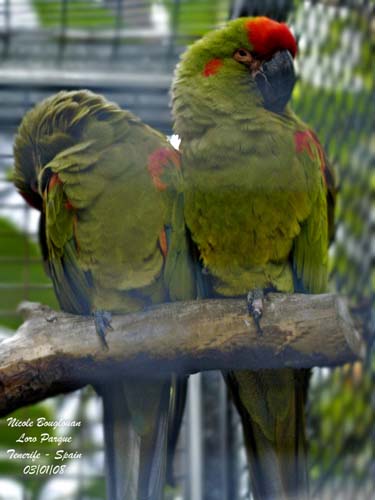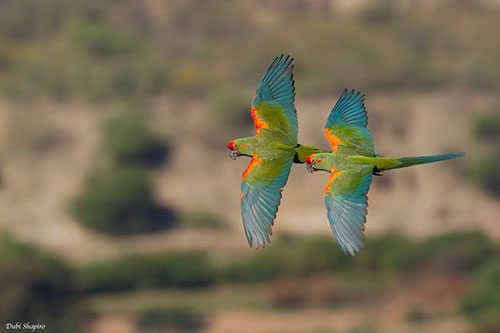
Red-fronted Macaw
Ara rubrogenys
Psittaciforme Order – Psittacidae Family
BIOMETRICS:
Length: 55 - 60 cm
Wingspan: 80 - 86 cm
Weight: 500 - 650 g
DESCRIPTION:
Red-fronted Macaw is endemic to Bolivia, living in very restricted area in the Andes.
Adult has olive-green plumage, with orange-red shoulders. Graduated tail is olive-green, with blue tips of feathers. On the wings, flight feathers are turquoise-blue.
On the underparts, body is green. Underwing shows orange-red lesser coverts and yellowish-green flight feathers. Thighs are red.
On the head, forehead, crown and ear-coverts are orange-red. The bare parts of the face are pinkish-red with fine lines of dark feathers.
Strong, hooked bill is black. Eyes are orange with bare pinkish-red eye-ring. Legs and feet are dark grey.
Both sexes are similar.
Juvenile is duller than adults, and lacks the orange-red patches on head and shoulders, or they are indistinct. Thighs are green washed orange. Eyes are brown.
REPRODUCTION:
Breeding season usually occurs between October and March, with the beginning of the rainfalls. It may vary slightly, in order to provide food enough to the young.
Red-fronted Macaw nests in cliff-faces, in fissures or rocky crevices, whereas most of macaws nest in holes in trees. But the habitat of the Red-fronted Macaw does not provide numerous large trees, cause to deforestation. This species often nests in loose colonies.
Female usually lays 1 to 3 white eggs. Incubation lasts about 26 days.
Young fledge about 70 to 73 days after hatching.
One pair usually rears one young per year.
DIET:
Red-fronted Macaw feeds on seeds and fruits, cultivated maize and peanuts.
PROTECTION / THREATS / STATUS:
Red-fronted Macaw is an endangered species. It lives in very restricted areas where degradation and deforestation for agriculture and grazing threaten this species.
Red-fronted Macaw is illegally trapped for pet-trade, and it is heavily persecuted because it damages the crops.
Birdlife Bolivia manages a conservation program since 2002, in order to protect this macaw and its habitat.
This species breeds well in captivity.
Update Year 2022
The Red-fronted Macaw could ultimately be less threatened than it seems.
A recent assessment of numbers based on a larger geographical area gives the following figures: 1160 individuals including 138 to 159 breeding pairs. To compare, only 807 individuals were counted in 2011.
These encouraging results were published in August 2022 in the journal Bird Conservation International.
Still highly threatened, the Red-fronted Macaw is no longer considered to be "Critically Endangered", but must now be classified as an "Endangered" species.
Fr: Ara de Lafresnaye
All : Rotohrara
Esp : Guacamayo de Cochabamba
Ital : Ara fronterossa
Nd : Roodwangara
Photographers:
Dubi Shapiro
Dubi Shapiro Photo Galleries
Nicole Bouglouan
PHOTOGRAPHIC RAMBLE
Text by Nicole Bouglouan
Sources:
HANDBOOK OF THE BIRDS OF THE WORLD volume 4 by Josep del Hoyo, Andrew Elliot and Jordi Sargatal – LYNX EDICION – ISBN 8487334229
PARROTS OF THE WORLD – An Identification Guide – by Joseph M. Forshaw – Princeton University Press – ISBN 0691092516
Wikipedia (Wikipedia, The Free Encyclopedia)
Ornithomedia - Le Web de l’Ornithologie
Breeding and global population sizes of the Critically Endangered Red-fronted Macaw Ara rubrogenys revisited

Update at the bottom of the page
VOICE: SOUNDS BY XENO-CANTO
Red-fronted Macaw gives abrupt, shrill calls. Alarm call is a raucous “raa-aaah”. Pair utters melodious duets.
HABITAT:
Red-fronted Macaw lives in mountainous semi-arid areas with cactus, thorny trees and scrub. It can be seen near farmlands and it feeds in cultivated areas.
This species needs cliff-faces for nesting and roosting, situated near water. It is visible between 1100 and 2500 metres of elevation, but it may disperse locally up to 3000 metres.
RANGE:
Red-fronted Macaw lives in very restricted area in Bolivia, on the East slope of the Andes, in central-southern Bolivia.
BEHAVIOUR:
Red-fronted Macaw feeds on plant matter such as cultivated crops of maize and peanut. It also feeds on seeds and fruits, and Cactus Cereus is important for this species.
Red-fronted Macaw wanders every day for food. They are usually seen in pairs or family groups, but large flocks congregate around water and food sources.
They sleep at communal roost by night in cliff-faces, and within the flock, pairs and family groups sleep together, close to each other. They leave the roost at dawn. First, they perch on trees near the feeding areas, in order to vocalise and preen. They fly from tree to tree and then, they reach the feeding area where they are very active in the morning and in the late afternoon. They drink together at riversides after feeding.
Red-fronted Macaw forages as on the ground or in trees. It rests during the hottest moments of the midday, perched in shady trees close to their feeding areas.
These macaws damage the crops, mainly those of maize and peanuts.
Red-fronted Macaw is resident and only performs some movements in search of food.
FLIGHT:
Red-fronted Macaw performs relatively high long-distance flights. It is very agile, and able to straight up and to hover. It performs powerful flight with steady shallow wing beats.
